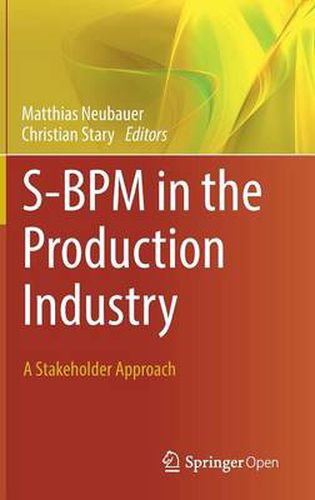Readings Newsletter
Become a Readings Member to make your shopping experience even easier.
Sign in or sign up for free!
You’re not far away from qualifying for FREE standard shipping within Australia
You’ve qualified for FREE standard shipping within Australia
The cart is loading…






This title is printed to order. This book may have been self-published. If so, we cannot guarantee the quality of the content. In the main most books will have gone through the editing process however some may not. We therefore suggest that you be aware of this before ordering this book. If in doubt check either the author or publisher’s details as we are unable to accept any returns unless they are faulty. Please contact us if you have any questions.
This book is open access under a CC BY-NC 4.0 license.
This volume presents several case studies highlighting the latest findings in Industry 4.0 projects utilizing S-BPM features. Their potential is explored in detail, while the limits of engineering a company from a communication-centred perspective are also discussed.
After a general introduction and an overview of the book in chapter 1, chapter 2 starts by condensing the industrial challenges driven by the German Industry 4.0 trend to form a concrete vision for future production industries. Subsequently, chapter 3 introduces the basic concepts of S-BPM and its capabilities, in particular for supporting the restructuring of processes. The next three chapters then present various case studies, e.g. at an SME offering the production of atypical, unique and special purpose machinery, equipment and technologically complex units particularly useful in the automotive and electronic industries; and at a further SME producing highly-customized floor cleaning machines. Rounding out the coverage, the last two chapters summarize the achievements and lessons learned with regard to the road ahead.
Overall, the book provides a realistic portrait of the status quo based on current findings, and outlines the future activities to be pursued in order to establish stakeholder-centred digital production systems. As such, developers, educators, and practitioners will find both the conceptual background and results from the field reflecting the state-of-the-art in vertical and horizontal process integration.
$9.00 standard shipping within Australia
FREE standard shipping within Australia for orders over $100.00
Express & International shipping calculated at checkout
This title is printed to order. This book may have been self-published. If so, we cannot guarantee the quality of the content. In the main most books will have gone through the editing process however some may not. We therefore suggest that you be aware of this before ordering this book. If in doubt check either the author or publisher’s details as we are unable to accept any returns unless they are faulty. Please contact us if you have any questions.
This book is open access under a CC BY-NC 4.0 license.
This volume presents several case studies highlighting the latest findings in Industry 4.0 projects utilizing S-BPM features. Their potential is explored in detail, while the limits of engineering a company from a communication-centred perspective are also discussed.
After a general introduction and an overview of the book in chapter 1, chapter 2 starts by condensing the industrial challenges driven by the German Industry 4.0 trend to form a concrete vision for future production industries. Subsequently, chapter 3 introduces the basic concepts of S-BPM and its capabilities, in particular for supporting the restructuring of processes. The next three chapters then present various case studies, e.g. at an SME offering the production of atypical, unique and special purpose machinery, equipment and technologically complex units particularly useful in the automotive and electronic industries; and at a further SME producing highly-customized floor cleaning machines. Rounding out the coverage, the last two chapters summarize the achievements and lessons learned with regard to the road ahead.
Overall, the book provides a realistic portrait of the status quo based on current findings, and outlines the future activities to be pursued in order to establish stakeholder-centred digital production systems. As such, developers, educators, and practitioners will find both the conceptual background and results from the field reflecting the state-of-the-art in vertical and horizontal process integration.